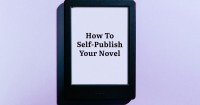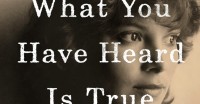
How to self-publish your novel
theverge.com – Monday April 1, 2019

Until recently, if you were a writer who had a novel or other work, there was essentially a single path to follow: you tried to find an agent who liked your writing, and who would be able to sell it to a publisher. The process could take months or years — assuming you were able to get on that merry-go-round at all.
David Gaughran, author of Let’s Get Digital and other books about self-publishing, tried that route when he wrote his first novel about 11 years ago. It was an exasperating experience.
“I spent about 18 months querying every agent that I could find in the English-language world and didn’t really get anywhere,” Gaughran says. He was frustrated enough that he thought about giving up. “But then I started looking at self-publishing.”
Since then, self-publishing has become far more than a last-ditch alternative to traditional publishing — it’s a choice that many authors are making from the starting line. But while it’s not all that hard to put out an ebook these days, finding an audience takes a lot more than simply uploading your manuscript and clicking publish: it means going through the entire publishing process on your own, from editing to artwork to marketing, putting your book’s success entirely in your own hands.

Pen Names: Don’t worry, you can deposit the check
By G. Miki Hayden
Instructor at Writer's Digest University online and private writing coach
firstwriter.com – Monday April 1, 2019

One of the topics I see some jawboning about is whether and why to use/not use a pen name (aka a nom de plume). Since the topic seems to fascinate, and many folks before they’ve even written the book seek out a name to write it under, I thought the subject was worth some air time.

How to Write Poetry About Conflict
theatlantic.com – Monday March 25, 2019

The poet Carolyn Forché has devoted much of her career to writing what she calls the poetry of witness. She coined the term in her introduction to Against Forgetting, a 1993 anthology in which she collected works by 145 “poets who endured conditions of historical and social extremity during the twentieth century.” Forché herself had not endured such conditions, but she had seen them. From 1978 to 1980, she traveled repeatedly to El Salvador, where she bore witness to the violent repression of Salvadoran citizens by that country’s military dictatorship.

The agent, her authors and the legal battles worthy of a bestseller
smh.com.au – Friday March 22, 2019

Selwa Anthony is ensconced on an avocado-green leather sofa, a chihuahua reclining on either side of her. The leading literary agent is small but commanding, a diminutive grande dame with sharp brown eyes and long purple fingernails. As always, she is carefully coiffured and glamorously dressed, as if her next appointment were a cocktail party. But Anthony's mood on this warm afternoon is more defiant than festive. "Everything I've done in my life has been boots and all," she says.
Literary agents are behind-the-scenes people. Their job is to foster writers' careers and secure them good publishing deals: they rarely make news in their own right. Yet Anthony has had a central role in not one but two headline-grabbing court cases in the past year. First, she was in the thick of a battle over the estate of her friend Colleen McCullough, best-known as the author of the blockbuster outback saga The Thorn Birds. Then came the showdown with her former star client, bestselling mystery-romance writer Kate Morton. Anthony, who initiated the legal action against Morton, ended up feeling that her own professional reputation was on trial. In the witness box, she was grilled for hours. "It was terrible, terrible, terrible," she says, as sunlight streams into her harbourside Sydney apartment.

All write now: writing is a numbers game
montclairlocal.news – Sunday March 17, 2019

I woke up this morning to a rejection email in my inbox. It was for a short, lyrical essay I had written and submitted nearly a year ago. A piece I was quite fond of. A piece I was hopeful would actually find a home. The rejection hurt more than usual, as my piece apparently went through several rounds of consideration and came close to being chosen for publication. SO! CLOSE! ::shakes fists at sky::
Still, after the briefest of mourning periods, I opened up the spreadsheet in which I tracked my numbers of pitches and submissions, moved this particular publication to the “rejected by” column, and considered where I might send my piece next. And that was that. Onward!

Writing the novel you want to see in the world
irishtimes.com – Saturday March 2, 2019

In 2014 Lisa Coen and I put out our first book under the Tramp Press banner. We were young. I was bullish, irritated by the over-productive, under-resourced, gate-keeping male-centric world of publishing we’d experienced as office juniors or unpaid interns.
We wondered: what if we could secure funding from the Arts Council to help us start out on our own, publishing just a few titles a year, focusing on nothing but their extraordinary quality?

Agent as editor
By G. Miki Hayden
Instructor at Writer's Digest University online and private writing coach
firstwriter.com – Tuesday February 26, 2019

Agent as editor. An oxymoron?
Some authors want their agents to act as first editor of the book and some don’t. Often agents will suggest changes even before they accept the writer as a client. Then you’re the one who will have to decide how badly you want that person to represent you.

Avoid These Bad Habits in Your Writing
lifehacker.com – Tuesday February 19, 2019

The top copy editor at Random House has a book out about what you should and shouldn’t do in your writing, and people are already arguing about it. All writing advice is relative, because language is not physics, it’s something people made up. That doesn’t mean writing advice is useless, so if you like to write and are trying to get better at it, you should read this excerpt from Benjamin Dreyer’s book Dreyer’s English: An Utterly Correct Guide to Clarity and Style.

Bestselling authors “spread their wings and challenge themselves,” an interview with authors Sara Connell & A.G. Howard
thriveglobal.com – Tuesday February 12, 2019

As part of my series on the “5 Things You Need to Know to Write a Bestselling Book,” I had the pleasure of interviewing A.G. Howard.
A.G. Howard, the #1 New York Times and international bestselling author of young adult retellings and adaptations. Her titles include theSplintered series,a gothic Alice in Wonderland spin-off; RoseBlood, a Phantom of the Opera–inspired adaptation; and her latest release, Stain, a gritty fairy tale/high fantasy inspired by The Princess and the Pea.

Query the Agent(s)
By G. Miki Hayden
Instructor at Writer's Digest University online and private writing coach
firstwriter.com – Monday January 28, 2019

How Many at a Time?
Writing the novel was easy—not! But now comes the hard(er) part. Getting an agent. Well, just take this trip one step at a time—or should I say several steps at time because you need to send out queries as if you were a query-packaging machine.
Get the free newsletter | Submit a news item or article | Get Writers' News for your website





